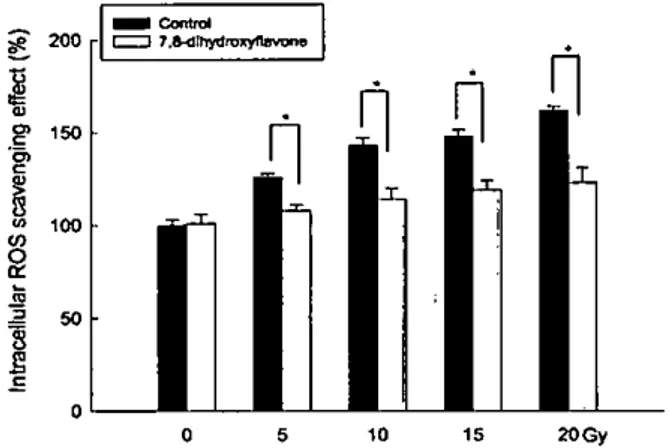rn;
도꾀꾀alof Medici굶굶d Lif강Science Vol. 6. No. 5. 2009] Role of7
,
8-dihydroxyflavone on y- ray radiation-induced reactive oxygen speciesproduction
Rui Zhang
,
Kyoìmg Ah Kang,
and Jin Won HyunDepartment이B
∞
hemis!ry,Jeju NationalU미ver잉Iy SCh∞
1이Medicine.Jeμ Korea Abslracllonizing radiation can induce axidative stress through generation 01 reactive oxygen species (ROS).Flavonoids are a member
。
f polyphenolic compounds that occur in frui!s,vegetables,teas and red wines. 7,8-dihydroxy’
lavone‘a member of thef1avonoidgrouP. was elucidated the free radical scavenging effecl against y-ray radiation-induced ROS production. We found 7,
8-dihydroxyflavone 10 scavenge the inlracellular ROS delecled 씨h fluorescence speclrometer and llow cytom'etry (J Med Ufe
Sci 2009;6:365-367)
Key Words : 7,8--dihydroxyflavone,Reactive oxygen species,Flavonoids
Inlroduclion Malerials and melhods
」
2. Cell culture and irradialion
Fi밍lre 1. Chemical structure of 7.8-dihydroxyflavone 1. Reagents
깨e 7. 8-dihy이。xyflavone (Fig. 1) was fresh!y dissolved
in dimethyl sulfoxide (DMSOl. yielding a fmal conc밍ntr8tion, which did not ex
∞
ed 0.1%. 2’.7 ’-dichlor여l띠drofluorescein diacetate (DCF-DA) was purchased from the Sigma Chemical Company (St. Louis. MO. USA)O
ι-:/
、、
OH
HO
Chinese hamslßr lung fihroblasts (V79-4) cells from the Amencan Type Culture Collection (Rockville. MD. USAl were maint8ined at 37't in an Încubator with a humidified atmosphere of 5% Cα and cultured in Du!becco's modified Eagle’s medium,containing 10% heat-inactivated feta! calf serum ,streptomycin (100 pg/mI) .and penicillin (100 units/mD 끼113cells were exposed to Y-ray radation at 1.5 Gy/min from a ooCo y-ray source (MDS Nordion C-188
Address for correspondence : Jin WonHyUn
Depa끼menl 01BiochemistryMedìcine,Jeju NationalUniversily SChool이Medicine,66 Jejudaehakno,690-756,Jeju,Korea E--rr녕iI:jinwonh@jeiunu.ac.kr
Radiation ωxicity occurs either by direct attack on the genetic material and/or by generating reactive oxygen species (ROS) 5uch as superoxide 밍lion,hydrox:yl radical. and hydrogen peroxide by radiolysis of walerJl. These free radicals react with cellular macromolecules 5uch as DNA‘
proæin ,lipid membrane‘and cause cell dysfunction and m
。
πality2l,ROS mediated bimolecular reactions and theirrelationship with radiation sickness is the current suQject of scientific investigations in radiotherapy:n. Antioxidants are capable of scavenging free-radica!s from the radiolysis of water thereby protec니ng cell damage4l‘thus supplementation
。
f antiox:idants to improve the efficacy of radiotherapy is today' s proposed sσalßgy5'Flavonoids are a member of p。이)henolic compounds that
。
ccur in fruits. vegetables,teas and red wines6l. Several reports have been demonsσ'ated the relationship between structure and activity for. antioxidant properties of flavonoids7-9l.RecenUy we have reported the e.fTectof 7, 8-dihydroxyflavone on hydrogen peroxide-induced DNA damage and cell deathlOlπ
113present study investigated whether 7,8-dihydroxyflavone is capable of reducing Y-rBYradiation-induced ROS production in hamster lung fibroblast cells (V79-4)RuiZhang.KyoungAh Kang.Jin WonHyun
standard source‘J~u National Universitr,J밍U‘Korea)
3. Inlracellular reaclive oxygen species (ROS) measurement
π113 V79-4 cells were σ.•aled with 7. 8-dihydroxyflavone at 10 밍I띠 and were cxposed ω y-.ray radiation an hour later. T↑113cells were incubated for an additional 24 h at 37
t. Afler adding 25 M of DCF-DA solution‘the nuorescence of 2'‘7’dichloronuorescein was detected using a Perkin
Elmer LS-5B spectronuorometer and a flow cytometer (Becton Dickinson. Mountain View‘CA. USA),respectivelyl1l
4,Slalislical analysis
All measurements were made ìn triplicate 어1d all values
were expressed as the means :!::: standard error of the mean (S.E.M.). The results were subjected to an analysis of variance (ANOVA) using the 1'ukey test to analyze the difference. P ( 0‘05 was considered significantly
0
0
0 5 '0 15 20Gy
Figure 3. Effect of 7.8-dihydroxyf1avone on scavenging intracellular ROS generated by y-ray irradiation at 10 Gy
깨e V79-4 cells were treated with.7.8-dihydroxyflavone at 10 μg/ml ,followed by y-ray irradiation at 10 Gy an hour later. Next. the cells were incubated for 48h‘the
intracel1ular ROS was detected using flow cytometer after DCF-DA staining
Con'rnl FI: 146
10Gy
"‘,.
7,6깅îhydro여avone+10Gy
.-,
---t
‘'"
t
‘”
••
.i
‘i ‘”•
•References
J) Quintiliani M 까113oxygen effect in radiation inactivation
。
f DNA and enzymes. lnt J Radiat Bi이Ralat Sωd PhYs Chem Med 1986;50:573-942) Ewing D. Jones SR. Superoxide removal and radiation protection in bacteria. Arch Biochem Biophys 1987:254 53-62
3) Conklin KA. Dietaly polyunsaturated fattr acids: impact cin cancer chemotherapy and radiation 쩌tern Med Rev
2002:7:4-21
4) M밍lsour HH,Hafez HF. Fahmy NM‘Hanafi N. Protective effect of N-acetyl앙steine against radiation induced DNA
-Role of 7.8-dihydroxyflavoneon y-ray radiation-induced reactive oxygen species production
damage and hepatic toxicity 'ÍIl rats. Biochem Phannacol
2008;75;773-80
、
5) Barker S,Weinfeld M,Zheng J,1i L,Murray D Identification of mammalian proteins cross-linked to DNA by ionizing radiation. J Biol Chem 2005;280;33826-38 6) Havsteen BH. The biochemishy and medical significance
of the flavonoids. Phannacol Ther 2002; 96:67-202 7) Rice- Evans CA,Miller NJ,Paganga G. Structure →
antioxidant activity relationships of flavonoids and phenolic acids. Free Radic Biol Med 1996:21:417
8) 1emanska K,Szymusiak H,얘rakowska B,Zielinski R,
Soffers AE,Rie1jens 1M. The influence of pH on
잉1'tioxidant proper↑;Ïes and the mechanism of antioxidant
action of hydroxyflavones. Free Radic Biol Med 2001;31:869-81
9) Melidou M,Riganakos K,Ga1arisD. Protec디on against nuclear DNA damage offered by flavonoids in cells exposed to hydrogen peroxide: the role of σ
。
n chelation Free Radic Biol Med 2005;39:1591-600367
lO)Zhang R,Kang KA,Piao MJ,Ko DO,Wang 때,Chang WY,You HJ,Lee IK,Kim BJ,Kang SS,Hyun JW Preventive effect of 7,8-dihydroxyflavone against
。
xidative stress induced genotoxicity. Biol Phann Bull 2009;32:166-711ÜRosenkranz AR,Schma1dienst S,Stuhlmeier KM. Chen W,Knapp W,Zlabinger GJ. A microplate assay for the detection of oxidative products using 2',7' dichlorofluorescin-diacetate. J Immuno1 Methods 1992: 156:39-45
12)Bhos1e 3M,Huilgol NG ,Mishra KP. Enhancement of radiation-induced oxidative stress and cytotoxicity in tumor cells by ellagic acid. Clin Chim Acta2oo5;359:89 100
13)Chα KM,Kang CM,Cho ES,Kang SM,Lee SB,Um HD lonizing radiation-induced micronucleus formation is mediated by reactive oxygen species that are produced in
